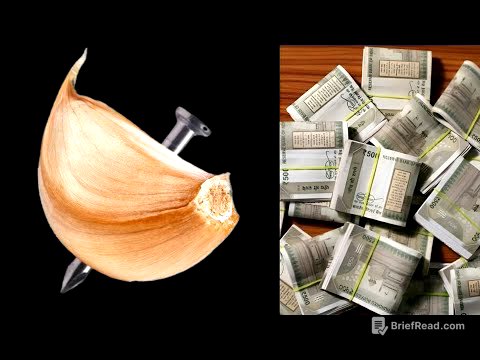TLDR;
This YouTube video by Chú Trí KYS provides a detailed explanation of energy in the context of spring pendulums and harmonic oscillators. It covers concepts such as potential and kinetic energy, their relationship, and how they oscillate over time. The video also includes practical problem-solving techniques and common pitfalls to avoid.
- Potential and kinetic energy in harmonic motion
- Energy transformations and conservation
- Graphical representation of energy over displacement and time
- Problem-solving techniques for spring pendulum systems
Intro [0:00]
The video introduces the topic of energy in spring pendulums, promising to cover both quantity and energy aspects based on a new book. The content aims to mix theoretical knowledge with practical applications, suitable for students learning about harmonic oscillators.
Mechanical Energy: Potential and Kinetic [0:32]
Energy in a system consists of potential and kinetic energy. The sum of these two energies equals the total mechanical energy. During mechanical energy conservation, potential energy converts to kinetic energy and vice versa, but the total energy remains constant. For example, if total energy is 10,000, potential and kinetic energy exchange values, but their sum always equals 10,000.
Kinetic Energy Formula and Derivation [1:38]
Kinetic energy is defined by the formula 1/2 MV^2. For a harmonic oscillator, V is replaced with Omega * A * sin(Omega * t + Phi). After squaring and trigonometric manipulation, the kinetic energy equation becomes 1/2 * m * Omega^2 * A^2 * (1 - cos^2). This simplifies to 1/2 * m * Omega^2 * A^2 - 1/2 * m * Omega^2 * x^2, linking kinetic energy to both amplitude and displacement.
Potential Energy and Mechanical Energy [3:20]
Mechanical energy is the sum of kinetic and potential energy. Kinetic energy is 1/2 * m * V^2, and potential energy is 1/2 * m * Omega^2 * x^2. The potential energy can also be expressed as 1/2 * m * Omega^2 * A^2.
Graphical Representation of Potential and Kinetic Energy [4:01]
Potential energy is represented as a quadratic function, a parabola opening upwards, while kinetic energy is a downward-opening parabola. At x=0, potential energy is minimal, and kinetic energy is maximal. Conversely, at X=A, potential energy is maximal, and kinetic energy is zero.
Potential Energy Formula and Graph Analysis [6:34]
The formula for potential energy is 1/2 * m * Omega^2 * x^2, which is always positive, resulting in an upward-facing parabola. Kinetic energy is highest at x=0, corresponding to Vmax. The graphs of these energies are shifted versions of sine and cosine functions, oscillating harmonically.
Energy Oscillation and Frequency [10:16]
Kinetic and potential energy oscillate in the form of sine or cosine functions, which are harmonic oscillations. The frequency of energy oscillation is twice the frequency of displacement (2 * Omega * t), meaning its frequency is double that of the oscillator (f_v = 2f_x). The period of energy oscillation is half the period of displacement.
Energy Translation and Cycle Analysis [13:19]
Energy graphs are always positive, which means they are translated upwards, and the negative part is cut. A full cycle of energy corresponds to half a cycle of displacement. For example, if an oscillator completes a cycle in 5 seconds, the energy cycle is 5/2 seconds.
Omega and Frequency Relationships [17:51]
The relationships between Omega, frequency, and period for energy and displacement are: Omega (energy) = 2 * Omega (oscillator), f (energy) = 2 * f (oscillator), and T (energy) = 1/2 * T (oscillator).
Spring Pendulum Energy [19:09]
For a spring pendulum, potential energy is 1/2 * m * Omega^2 * x^2, where m * Omega^2 equals k. Thus, potential energy is 1/2 * k * x^2. The maximum potential energy is 1/2 * k * A^2, where A is the amplitude. Kinetic energy equals mechanical energy minus potential energy, or 1/2 * k * (A^2 - x^2).
Problem-Solving Techniques [22:42]
When solving problems, it's more convenient to use potential energy formulas (1/2 * k * A^2 and 1/2 * k * (A^2 - x^2)) rather than kinetic energy formulas derived directly from 1/2 * m * V^2.
Key Notes on Energy in Harmonic Motion [23:52]
Key points include: the frequency of energy oscillation is twice that of displacement. Potential energy is 1/2 * k * A^2. Mechanical energy is proportional to the square of the amplitude, not the amplitude itself. Mechanical energy depends on the spring's stiffness (k) and amplitude (A), not the mass (m). Kinetic and potential energy vary in opposite phases.
Special Angles and Energy Distribution [29:12]
At 0 degrees, potential energy is highest, and kinetic energy is zero. At pi/2, kinetic energy is highest, and potential energy is zero. At pi/6, potential energy is three times kinetic energy. At pi/4, kinetic and potential energies are equal.
Sample Questions and Solutions [37:45]
The video presents several multiple-choice questions related to energy in harmonic motion, offering detailed explanations for each answer. These questions cover topics such as the relationship between kinetic and potential energy, the impact of displacement on energy, and the properties of mechanical energy.
Advanced Problem-Solving and Key Concepts [54:07]
The video continues with more complex problem-solving, emphasizing the importance of understanding the underlying concepts rather than memorizing formulas. It addresses common misconceptions and tricky aspects of energy in harmonic motion.
Spring Pendulum Variations and Problem-Solving [1:20:14]
The video tackles problems involving spring pendulums, including scenarios where the spring's length is altered. It introduces concepts such as the relationship between spring length and stiffness and how changes affect the system's energy.
Advanced Concepts: Cutting Springs and Energy Loss [1:42:20]
The video explores advanced topics such as cutting a spring and the resulting changes in potential energy. It introduces the concept of "locking up potential energy" and provides formulas for calculating energy loss.
Mock Exam Questions and Detailed Solutions [2:01:05]
The video presents a series of mock exam questions, offering step-by-step solutions and explanations. These questions cover a wide range of topics, from basic energy calculations to more complex scenarios involving spring pendulums and harmonic motion.
Advanced Problem-Solving Techniques and Insights [2:12:13]
The video shares advanced problem-solving techniques, such as using the Pythagorean theorem and understanding the relationship between velocity and acceleration. It emphasizes the importance of visualizing the problem and using appropriate formulas.
Final Problems and Comprehensive Review [2:26:35]
The video concludes with a few final problems, providing a comprehensive review of the key concepts covered. It emphasizes the importance of understanding the underlying principles and applying them to solve a variety of problems.
Identical Spring Pendulums and Proportionality [2:39:30]
The video addresses scenarios involving two identical spring pendulums with different amplitudes. It explains that mechanical, potential, and kinetic energies are proportional to the square of the amplitude.
![[Lớp 11] Buổi 11. Năng lượng con lắc lò xo](https://wm-img.halpindev.com/p-briefread_c-10_b-10/urlb/aHR0cDovL2ltZy55b3V0dWJlLmNvbS92aS9adTRKYXBGTXpBZy9tYXhyZXNkZWZhdWx0LmpwZw==.jpg)








